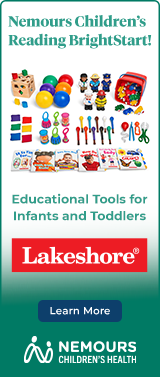The use of positional words is important for your child’s understanding of space and location. As your child is becoming more independent and able to carry out tasks, he realizes that the position of things is often an important detail. For example, if you’ve asked your child to get a book that is on the bed, you don’t want him looking under the bed for the book! Many of these positional words can be related to tasks that encourage your child’s independence. For example, you may ask him to push the chair under the table or put the cup beside the sink. This activity gives your child a chance to listen closely to directions and illustrate his understanding of positional words while making a work of art!
Examples of positional words:
- above
- around
- behind
- below
- beside
- between
- down
- in front of
- in the center
- in the middle
- inside
- near
- next to
- on
- outside
- over
- through
- under
- up
- piece of paper
- drawing tools (crayons or markers)
Step 1: Say this variation of the finger play “The Little Turtle” to your child. Add finger motions to go with the words.
There was a little turtle that lived inside a box
He swam around a puddle and he climbed next to the rocks.
He snapped at a mosquito, he snapped at a flea
He snapped at a minnow and he snapped at me.
He caught the mosquito. He caught the flea.
He caught the minnow but he didn’t catch me.
Step 2: After you have said the rhyme, provide paper and crayons or markers in various colors. Invite your child to play a listening and drawing game that will help him practice positional words and listening skills.
You might say,
We are going to play a listening and drawing game. I will need you to listen very closely and draw each shape that I tell you. When we are finished, you will have made a beautiful picture! Are you ready?
Step 3: Slowly say each step, one at a time. Give your child enough time to draw the item between each step. Repeat the step if needed. Offer your help if he is unsure of the correct location in which to draw on the paper. Below is a suggested list of steps:
- Draw a large green circle in the middle of the page.
- Draw two small red squares below the circle.
- Draw two small red squares above the circle.
- Draw a small blue circle next to the large green circle.
- Draw a happy face inside the small blue circle.
- Draw a large brown square around your picture.
- Write your name at the top of the page.
- What did you draw? A turtle inside a box!
Step 4: Praise your child for being a good listener!
Step 5: Encourage him to complete the picture by coloring the shapes, if he hasn’t already.
Step 6: Ask him to tell you about the illustration and encourage him to use positional words.
To make it easier, give your child fewer steps. Slowly tell him the first step, and repeat it. Repeat it again if your child needs to hear it again. Give him enough time to draw the item. If he is unsure of the correct location on the paper, offer your help. Below is a suggested list of steps:
- Draw a green circle in the middle of the page.
- Draw two lines below the circle.
- Draw two lines above the circle.
- Draw a small blue circle next to the green circle.
- Draw two eyes and a mouth inside the blue circle.
To add some challenge, add more shapes and provide directions that include drawing objects as well as shapes. Remind your child to listen closely!
You might say:
- Draw a large green circle in the middle of the page.
- Draw two small red squares below the circle.
- Draw two small red squares above the circle.
- Draw a small blue circle next to the large green circle.
- Draw a happy face inside the small blue circle.
- Draw a large brown square around the circle.
- What did you draw? A turtle. Now, let’s add some details.
- Draw a puddle around the turtle.
- Draw rocks next to the turtle.
- Draw a black mosquito near the turtle.
- Draw a purple minnow under the turtle.
- Draw a yellow sun in the top right corner.








